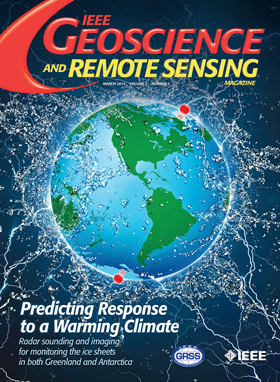宇宙1500轨道X波段真孔径侧视雷达:乌克兰IEEE里程碑候选
IF 16.2
1区 地球科学
Q1 GEOCHEMISTRY & GEOPHYSICS
引用次数: 0
摘要
在历史背景下,我们回顾了苏联宇宙-1500卫星上轨道X波段真孔径侧视雷达(RA-SLR)的开发和运行。这种雷达是在20世纪80年代初构思、设计和测试的,然后由乌克兰国家科学院O.Y.Usikov放射物理与电子研究所(IRE)的Anatoly I.Kalmykov教授(1936–1996)领导的乌克兰科学家和工程师团队在轨道上进行监督。它有一个磁控管源,一个12米可展开的开槽波导天线,以及一个车载信号处理单元。1983年秋天,宇宙-1500的单反相机进入极地地球轨道仅五天后,就没有进行预先计划的细致实验,而是提供了真正出色的服务。它提供了一系列极地海冰条件的微波图像,使北冰洋的货轮得以获救。两年后,类似的图像在南极一艘机动船只的救援中同样重要。然而,通往成功的道路远非一帆风顺。除了技术问题,卡尔梅科夫还必须克服家乡研究所管理部门、莫斯科研究实验室的同事和苏联高层官僚机构的嫉妒和敌意。后来,卡尔梅科夫的雷达被释放到工业中,成为苏联和俄罗斯系列遥感卫星Okean和乌克兰卫星Sich-1和Sich-1M的主要仪器。我们认为,Cosmos-1500的RA-SLR是乌克兰IEEE里程碑的一个很好的候选者。本文章由计算机程序翻译,如有差异,请以英文原文为准。
The Orbital X-Band Real-Aperture Side-Looking Radar of Cosmos-1500: A Ukrainian IEEE Milestone candidate
We revisit the development and operation of the orbital X-band real-aperture side-looking radar (RA-SLR) onboard the USSR satellite Cosmos-1500 in the historical context. This radar was conceived, designed, and tested in the early 1980s and then supervised, in orbit, by a team of Ukrainian scientists and engineers led by Prof. Anatoly I. Kalmykov (1936–1996) at the O. Y. Usikov Institute of Radiophysics and Electronics (IRE) of the National Academy of Sciences of Ukraine (NASU). It had a magnetron source, a 12-m deployable slotted-waveguide antenna, and an onboard signal processing unit. Instead of preplanned meticulous experiments, only five days after placement into the polar Earth orbit in the autumn of 1983, the SLR of Cosmos-1500 rendered truly outstanding service. It provided a stream of microwave images of the polar sea ice conditions that enabled the rescue of freighters in the Arctic Ocean. Two years later, similar imagery was equally important in the rescue of a motor vessel (MV) in the Antarctic. However, the way to success was far from smooth. Besides the technical problems, Kalmykov had to overcome the jealousy and hostility of his home institute administration, colleagues from Moscow research laboratories, and high-level USSR bureaucracy. Later, Kalmykov’s radar was released to the industry and became the main instrument of the USSR and Russian series of remote sensing satellites Okean and Ukrainian satellites Sich-1 and Sich-1M. We believe that the RA-SLR of Cosmos-1500 is a good candidate for the status of an IEEE Milestone in Ukraine.
求助全文
通过发布文献求助,成功后即可免费获取论文全文。
去求助
来源期刊

IEEE Geoscience and Remote Sensing Magazine
Computer Science-General Computer Science
CiteScore
20.50
自引率
2.70%
发文量
58
期刊介绍:
The IEEE Geoscience and Remote Sensing Magazine (GRSM) serves as an informative platform, keeping readers abreast of activities within the IEEE GRS Society, its technical committees, and chapters. In addition to updating readers on society-related news, GRSM plays a crucial role in educating and informing its audience through various channels. These include:Technical Papers,International Remote Sensing Activities,Contributions on Education Activities,Industrial and University Profiles,Conference News,Book Reviews,Calendar of Important Events.
 求助内容:
求助内容: 应助结果提醒方式:
应助结果提醒方式:


